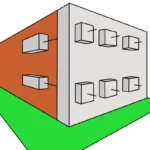The realm of civil engineering and construction is brimming with terms and concepts that may seem bewildering at first. One such concept is pavement, which is essential for our roads and streets. But did you know that there are two main types of pavement: flexible and rigid? In this article, we’ll delve into the differences between the two and how they influence our daily lives.
Flexible Pavement: Resilience in Asphalt
Flexible pavement, as the name suggests, is characterized by its remarkable adaptability and elasticity compared to its rigid counterpart. Its structure typically consists of multiple layers, starting with a soil and coarse aggregate base, followed by a layer of finer aggregates, and culminating in a top layer of asphalt. This impressive flexibility allows it to adjust to deformations and changes on the surface, making it an ideal choice for regions with variable weather conditions and soil prone to movement.
Widely known as asphalt pavement, this type enjoys considerable popularity worldwide due to its unique properties and advantages in a wide variety of environments. Next, we’ll delve into its components, construction process, and highlight some of its outstanding characteristics.
Components of Flexible Pavement:
Soil Base: The lower layer of flexible pavement is usually a compacted soil base. This layer provides structural support and helps distribute traffic loads evenly to the underlying soil. The type of soil used depends on local conditions and the required load-bearing capacity.
Coarse Aggregates: A layer of coarse aggregates is placed over the soil base, acting as a drainage and stability base. These aggregates provide a leveled surface and help prevent erosion of the underlying soil.
Fine Aggregates: On top of the coarse aggregates, a layer of finer aggregates is placed, serving as a transition layer between the base and the upper asphalt layer. This layer helps distribute traffic loads evenly and provides a suitable surface for asphalt adhesion.
Asphalt Layer: The top layer of flexible pavement consists of asphalt, a mixture of bitumen and mineral aggregates. Asphalt provides a smooth and wear-resistant surface suitable for vehicle traffic. The asphalt mixture is poured, compacted, and leveled to create a uniform surface.
Construction of Flexible Pavement:
The construction of flexible pavement is a meticulous process involving several steps to ensure durability and proper strength over time. Below, we’ll delve into the key steps that make up flexible pavement construction:

Ground Preparation: This essential step involves preparing the underlying terrain. The soil is leveled and compacted to create a solid and uniform base on which the flexible pavement will be built.
Placement of Soil Base: On the leveled base, a layer of soil base is placed, which may consist of materials like gravel or crushed stone. This layer acts as structural support and helps distribute traffic loads evenly.
Aggregate Layers: Successive layers of coarse and fine aggregates are placed over the soil base. Coarse aggregates provide stability and drainage, while fine aggregates help create a suitable surface for asphalt adhesion.
Asphalt Mixing and Placement: The top layer of flexible pavement consists of an asphalt mixture, usually heated before being poured over the fine aggregates. Heavy machinery, such as compaction rollers, is then used to compact and level the asphalt.
Finishing: The pavement surface is carefully leveled and adjusted to ensure a smooth and uniform road or street. This is achieved using finishing tools and specialized equipment.
Compaction and Curing: After asphalt placement, proper compaction is essential to eliminate potential air pockets and achieve the desired density. Subsequently, the asphalt is allowed to cure for a specific period, enhancing its strength and durability.
Maintenance and Repairs: Throughout the flexible pavement’s lifespan, preventive maintenance tasks such as crack sealing and repairing damaged areas are performed. These actions help extend the pavement’s lifespan and keep it in good condition.
It’s important to note that construction quality is fundamental to the durability and performance of flexible pavement. Each step must be executed precisely and in compliance with local standards and regulations. Additionally, climate and local conditions can influence the construction process, requiring careful planning and adaptations as needed.
Key Features of Flexible Pavement:
Flexibility and Adaptability: One of the most notable features of flexible pavement is its ability to adapt to surface deformations and movements. It can withstand loads and soil movements without suffering significant damage, making it ideal for areas subject to seasonal changes, vibrations, and temperature fluctuations.
Fatigue Resistance: Flexible pavement is known for its ability to resist fatigue caused by constant traffic. As vehicles pass over it, flexible pavement can regain its original shape due to its elasticity. This prevents early formation of cracks and fissures, contributing to its longevity.
Relatively Simple Maintenance: Compared to other pavement types, such as rigid pavement, flexible pavement maintenance tends to be simpler and more cost-effective. When issues like minor cracks or potholes arise, they can be efficiently repaired through patching or sealing, reducing road downtime and maintenance costs.
Noise Absorption: Asphalt, the primary material of flexible pavement, has the ability to absorb traffic noise, resulting in quieter roads and streets. This is especially beneficial in urban and residential areas, reducing noise pollution and improving residents’ quality of life.
Rapid Construction: Flexible pavement construction tends to be faster, aiding in minimizing traffic disruptions and allowing for quicker recovery of road infrastructure.
Design Flexibility: Flexible pavement offers flexibility in design, meaning it can be adapted to different road configurations and load requirements. This makes it suitable for a wide range of applications, from urban roads to airports and parking lots.
Lower Initial Costs: Overall, flexible pavement usually has lower initial costs compared to rigid pavement, making it attractive for projects with limited budgets.
Recyclability: The asphalt used in flexible pavement is recyclable. This means that at the end of its lifespan, it can be recycled and reused in new paving projects, reducing waste and environmental costs.
Rigid Pavement: The Solidity of Concrete
On the other hand, rigid pavement is constructed using a single layer of reinforced concrete. Unlike asphalt, concrete is rigid and does not easily adapt to changes on the surface, meaning it is less tolerant to deformations and soil movements.

Rigid pavement, also known as concrete pavement, is a significant choice in road and street construction worldwide. Below, we’ll explore in more detail its key features, advantages, and disadvantages.
Key Features of Rigid Pavement:
Structural Strength: One of the standout features of rigid pavement is its exceptional structural strength. The concrete used in its construction can withstand heavy traffic loads and distribute them efficiently. This makes it an ideal choice for areas with heavy traffic, such as highways, main streets, and airports.
Long-Term Durability: Rigid pavement has a significantly prolonged lifespan compared to other types of pavement. It can withstand erosion, abrasion, and adverse weather conditions for decades without requiring a complete overhaul. This reduces long-term maintenance costs and minimizes traffic disruptions.
Low Long-Term Maintenance: The maintenance needed for rigid pavement tends to be lower compared to flexible pavement over its lifespan. Fewer repairs and preventive maintenance activities are required.
Heavy Load Capacity: Rigid pavement is especially suitable for areas expecting heavy load traffic, such as cargo trucks and heavy vehicles. It can withstand significantly higher loads without deforming or cracking, making it the preferred choice in industrial and freight transport areas.
Higher Reflectivity: Some types of concrete used in rigid pavement, especially those of light color or with reflective additives, can enhance road reflectivity. This improves nighttime visibility and can contribute to road safety.
Wear and Erosion Resistance: Concrete is highly resistant to wear caused by tire friction and deterioration from substances like oil and salt. This makes it suitable for areas anticipating significant exposure to these factors.
Dimensional Stability: Rigid pavement maintains its shape and leveling over time, reducing the need for frequent adjustments and ensuring a uniform and safe surface for vehicles.
Sustainability: The concrete used in rigid pavement is recyclable, allowing for reuse in future projects. Additionally, its durability contributes to reducing construction and demolition waste.
Construction Process of Rigid Pavement:
The construction of rigid pavement involves the following key steps:
Ground Preparation: This is the initial step and is crucial to ensuring a solid base. The underlying terrain is leveled and compacted to eliminate irregularities and provide a suitable surface for concrete placement.
Design and Planning: Before construction, a detailed design of the pavement is created, including the appropriate thickness of the concrete slab, the location of control and expansion joints, and other technical details. This ensures that the pavement meets local standards and requirements.
Placement of Reinforcement Mesh (Optional): In some situations, a steel reinforcement mesh may be placed over the compacted base before pouring the concrete. This mesh helps prevent cracking and enhances the pavement’s strength, especially in areas prone to heavy loads.
Concrete Preparation: The concrete used in rigid pavement must meet precise design specifications. This includes the proper mix of cement, aggregates, water, and, in some cases, additives to enhance concrete strength or durability.
Concrete Pouring: The concrete is poured onto the prepared surface in sections or slabs. It is then spread, leveled, and smoothed using screeds and finishing tools. It’s crucial to work quickly to prevent the concrete from starting to harden before proper leveling.
Creation of Control and Expansion Joints: Control and expansion joints are created on the concrete surface to control crack formation and allow for pavement expansion and contraction due to temperature changes. These joints are cut or created using specific tools.
Concrete Curing: After pouring the concrete and creating the joints, the curing process is essential. This involves keeping the concrete surface moist and protected for a specific period, usually several days. Proper curing enhances the strength and durability of the concrete.
Joint Sealing: Control and expansion joints are sealed with elastomeric materials or joint sealants to prevent water and debris infiltration, which can damage the concrete slab over time.
Final Finishing: A final finish is applied to the concrete surface to ensure it is level, smooth, and meets quality standards.
Maintenance and Repair: Throughout the lifespan of rigid pavement, preventive maintenance tasks, such as crack repair and joint sealing, are carried out. These actions prolong the pavement’s lifespan and maintain its structural integrity.

The construction process of rigid pavement is highly technical and requires meticulous planning, attention to detail, and compliance with local regulations. When executed correctly, rigid pavement provides a high-strength, durable surface suitable for areas with heavy traffic and adverse weather conditions.
Advantages and Disadvantages
Advantages
Flexible Pavement
Adaptability to Deformations: Flexible pavement is more adaptable and elastic than rigid pavement. It can withstand minor deformations without significant damage, making it suitable for areas with soil movement and seasonal changes.
Simpler Maintenance and Repairs: When damaged, repairs on flexible pavement are usually simpler and more economical. Affected areas can be patched or sealed easily, reducing road downtime.
Less Rolling Noise: Asphalt tends to generate less rolling noise compared to concrete, contributing to reduced noise pollution in urban and residential areas.
Higher Reflectivity: Light-colored asphalt can increase road reflectivity, improving nighttime visibility and reducing the need for additional lighting.
Lower Initial Costs: Flexible pavement generally has lower initial costs compared to rigid pavement, making it attractive for projects with limited budgets.
Ease of Maintenance: Maintenance operations, such as crack sealing and surface coating, are simpler to carry out on flexible pavement.
Rigid Pavement
Long-Term Durability: Rigid pavement is known for its exceptional durability and extended lifespan. It can withstand weather elements, abrasion, and adverse environmental conditions for decades.
Heavy Load Capacity: It is particularly suitable for areas with heavy traffic and loads, such as airports, main roads, and industrial areas. It can withstand significantly higher loads without deforming.
Reduced Long-Term Maintenance: The maintenance required for rigid pavement tends to be lower over its lifespan compared to flexible pavement. Fewer repairs and preventive maintenance activities are needed.
Reflectivity: Certain types of concrete used in rigid pavement, especially those of light color or with reflective additives, can enhance road reflectivity, improving nighttime visibility.
Sustainability: The recyclability of concrete used in rigid pavement allows for reuse in future projects, contributing to waste reduction in construction and demolition.
Disadvantages
Flexible Pavement
Less Long-Term Durability: Flexible pavement tends to have a shorter lifespan than rigid pavement and may require more maintenance over time.
Lower Load Capacity: In general, flexible pavement is less suitable for areas with very heavy traffic, such as ports and airports, compared to rigid pavement.
Permanent Deformations: Under repeated loads and high temperatures, flexible pavement may experience permanent deformations known as rutting, requiring specific repairs.
Less Tolerance to Temperature Changes: It may be more susceptible to the effects of extreme temperature changes, leading to pavement expansion and contraction.
Need for Continuous Maintenance: While repairs are simpler, flexible pavement may require more frequent maintenance and renovations compared to rigid pavement.
Higher Vulnerability to Chemicals: Asphalt is more susceptible to damage from chemicals, such as spilled oil and chemicals.
Rigid Pavement
Higher Initial Costs: The installation of rigid pavement is typically more expensive than flexible pavement due to the initial investment in specialized materials and equipment.
Less Tolerance to Deformations: Unlike flexible pavement, rigid pavement is less tolerant to soil deformations and temperature fluctuations, leading to the formation of uncontrolled cracks and fissures over time.
Increased Rolling Noise: Rigid pavement can generate higher rolling noise compared to flexible pavement, which may be a consideration in urban areas.
More Difficulty in Repairs: If damaged, repairs on rigid pavement can be more complicated and costly compared to flexible pavement. Demolition and reconstruction may be necessary in some cases.
Less Adaptability to Surface Changes: Rigid pavement is less adaptable to deformations and changes on the surface, making it more prone to the appearance of cracks on unstable soils.
Greater Initial Construction Time: The construction of rigid pavement typically requires more time compared to flexible pavement due to concrete curing times and other processes.
Conclusion
In summary, the construction of flexible pavement is a complex process involving multiple stages, from site preparation to asphalt application and meticulous finishing. This procedure is essential to ensure the creation of high-quality surfaces crucial for our roads and streets, contributing significantly to safe and efficient mobility in our communities.
On the other hand, rigid pavement offers several notable advantages, such as exceptional durability and the ability to withstand heavy loads. However, it is crucial to consider that it involves higher initial costs and provides less flexibility in terms of adapting to deformations. The choice between rigid and flexible pavement depends on various factors, including traffic levels, weather conditions, available budget, and the specific needs of the road or street being constructed. Both types of pavement play a crucial role in our road infrastructure and should be carefully selected based on the particular circumstances of each project.








Related
What is Rigid Pavement?
What is Flexible Pavement?
What is Steel Fiber Concrete in Pavements?